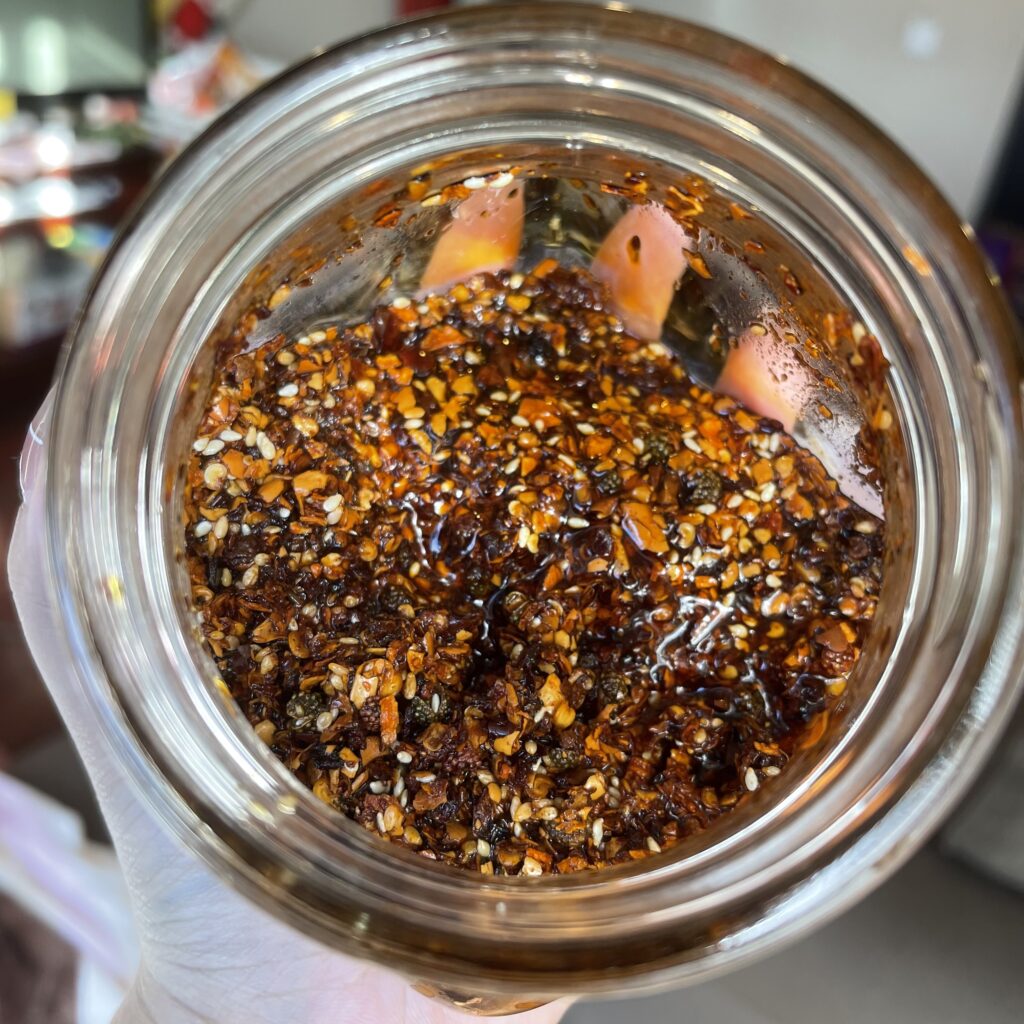Team Member: Jialin He, Jingjing Jiang
Learning Outcomes:
Participants will be able to do the following by the end of this blog:
- Understand what chilli oil is
- Learn Steps of making chilli oil
- Know what chilli oil means to Chinese people and why is it important
- Learn the uses of chilli oil
Introduction:
Chilli oil is made from dried chilli, chilli powder, vegetable oil, Chinese spice powder, white pepper, white sesame, cumin powder, star anise, Sichuan pepper, fragrant leaves, green pepper, cinnamon and cuoguo. Chinese people love chilli oil as much as Koreans love spicy Korean cabbage. Chilli oil has become one of the essential condiments in every household. It is the secret to delicious cooking and a national custom of the Chinese people. If someone has ever visited China, they will find a glass bottle of handmade chilli oil on the table in almost every restaurant. Handmade chilli oil is entirely different from the chilli oil you can buy in the supermarket. Supermarket chilli oil is mass-produced and has a saltier taste, like Lao Gan Ma (China’s famous chilli oil brand). Handmade chilli oil will be more transparent, so people can know exactly what ingredients are used. The oils you choose will also be healthier. Homemade chilli oil is the best choice for hygiene, cost and taste.


Learning strategy of multimedia elements
Through our study of multimedia technology this semester, we chose to use video production to share our teaching content with you. According to the cognitive theory we learned this semester, there is a limit to the amount of knowledge our brain can receive while learning, and at the same time, too much content can lead to increased pressure on the learner during the learning process, thus leading to a decrease in learning efficiency. Combining the Split-attention principle, combining text and pictures with video content can make our videos more vivid and attractive. Compared with a single text narration or slide presentation, based on the principles of personalization, sound, embodiment, and images, I think video instruction can bring a better visual experience to the audience. Adding sound narration and editing the production process in the video presentation, combined with sound narration and text labelling, can bring both visual and auditory experience to the viewers, thus increasing their interest and learning motivation. The addition of background music in the video can make the atmosphere of the video softer, increase the fun of the video and reduce the tension of learning at the same time. We also added some subtitles to the video to briefly label the main ingredients, tools and essential steps of making chilli oil to ensure that the text content is not too much while playing aid to learning, which allows learners to take notes more easily when watching and quickly find keywords and primary content, which is more in line with the signal principles we have learned.
My teammate and I made a video on making chilli oil to help you follow our steps to make healthy chilli oil at home. In this video, we are going to cover the ingredients and tools to make chilli oil and present it as a video clip. Although chilli oil can be purchased in many ways, such as Lao Gan Ma, the authentic Chinese traditional handmade chilli oil is unique. Handmade chilli oil is a good choice from its health perspective, cost, and taste.
To help audiences make better in chilli oil, we will cover the following area:
A. Written description, including the English of the ingredients used
B. Voice description, which includes background music, voice explanation
C. Learning objects and the importance of chilli oil
After watching our videos and blogs, you can learn how to prepare the materials and the production steps. At the end of the video, we also provided the dishes that used chilli oil, like noodles and Chinese salad.
Why chilli oil is important to the Chinese?
The importance of chilli oil to Chinese people may also be the basis of China’s love of spicy food. Chinese people’s habit of eating spicy food originated from the weather in some regions, for example, wet and cold southwest areas such as Sichuan, Guizhou and other regions. They choose to eat spicy food to keep their body warm by eating spicy food. Eating spicy food can stimulate people’s taste, and over time, Chinese people tend to prefer spicy food more and more. So chilli oil will add spicy to a lot of non-spicy foods. For example, cold dishes are not spicy, but chilli oil will make the dish more appetizing. The Chinese often say that chilli oil is the “soul” of a dish. At the same time, chilli oil is the most convenient and direct way to add spicy to people’s meals. People do not need to recook the whole dish; add a spoonful of chilli oil to the dish and stir it. This is why many Chinese students choose to make chilli oil because they miss the taste of home.
The uses of chilli oil:
1. Go with traditional Chinese food, such as dumplings
2. Stir-fried vegetables, Hot pot,
3. Any noodles and rice: Pho Noodle, Rice Noodle, Noodle Soup, Fried Rice
Anything you want to make spicy can be made with chilli oil, which has a long shelf life.
If you run into problems, you can always give us the comments on the blog pages. At the same time, if you find other amazing ways to use chilli oil, please feel free to share feedback with us (Hint: try to combine with western food, maybe you will find a new discovery). We hope you can enjoy the chilli oil. Good Luck!
Recent Comments